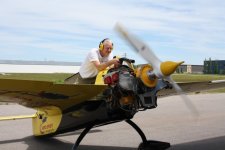Nobody likes standing close to a spinning prop which is why after several customers reported their Magnet Position values to us and they agreed with what we were seeing, we removed the parts about checking timing with a light a quite few years back. Also note, we had transposed some of the values on early Lycoming kits, having 88 and 97 entered primary/backup. Should be 97/88. Issued a SB and tried to contact all who were affected.
We are not sure why some people are finding variations in timing when observing with a light. The drill jig puts the magnet hole in the same place every time, based off the factory T/C mark on the back of the flywheel and the 12 tooling holes where the jig bolts to.
A variation of perhaps 1 degree is possible with different magnet air gaps to the sensor as the magnetic field is toroid shaped and air gap will slightly change the point where the edge of the field triggers the Hall Effect.
I've checked a few and never seen it off more than 1 degree.
If you wish to check with a timing gun, you need to be in a shaded place and on some RVs can stand up in the cockpit (sliders anyway) to observe without being anywhere close to the prop. You can also tape a video camera on top of the cowling to check. Put a white or silver piece of tape on the timing mark you'll be using. Black tape on either side of this for more contrast. You generally will see nothing in bright sunlight on a stock, flywheel.
The case split is the reference mark and you will probably have to project this forward with some sort of pointer closer to the flywheel to avoid parallax error.
Be sure to set ECU timing value the same as where you have a timing mark on the flywheel, (say 10 deg BTDC) at the rpms you are checking at (very important or the whole process is invalid). We recommend setting 750, 1000 and 1100 rpm at 10 deg and idle the engine at 900-1000. Also be sure MAP retard/ advance values are set to 0 so they don't modify timing.
Be sure to swap the inductive gun pickup to the correct plug when you check the other ECU. Magnet Position is different on each ECU in a dual setup.
Be sure your primary (green) Hall cable goes to the top most ECU, red cable to lower ECU. Timing will be way off if these are transposed. You'll have a huge mag drop and high CHTs usually.
If you drilled your flywheel using the wrong hole, timing is likely to be 30 deg off. It will run run horribly or kick back usually.
Don't swap a 360 flywheel onto a 320. There is a master lug location difference plus the holes are bigger on 360s.
I mention all of these points because someone or several people have made one or all of these mistakes.
To answer Larry's original question, we recently had a Franklin owner set Magnet Position statically and found it was 3 deg advanced when checked with a light after reporting high CHTs. All was well after the proper timing was dialed in.
Ok, the photo isn't an RV but it gives you an idea of how this can be done safely if you want to check Magnet Position accuracy. Note back of the airplane is in the shadow of the hangar.





